TOYOTA COROLLA HATCHBACK 2020 Warranties & Maintenance Guides (in English)
Manufacturer: TOYOTA, Model Year: 2020, Model line: COROLLA HATCHBACK, Model: TOYOTA COROLLA HATCHBACK 2020Pages: 260, PDF Size: 8.54 MB
Page 221 of 260
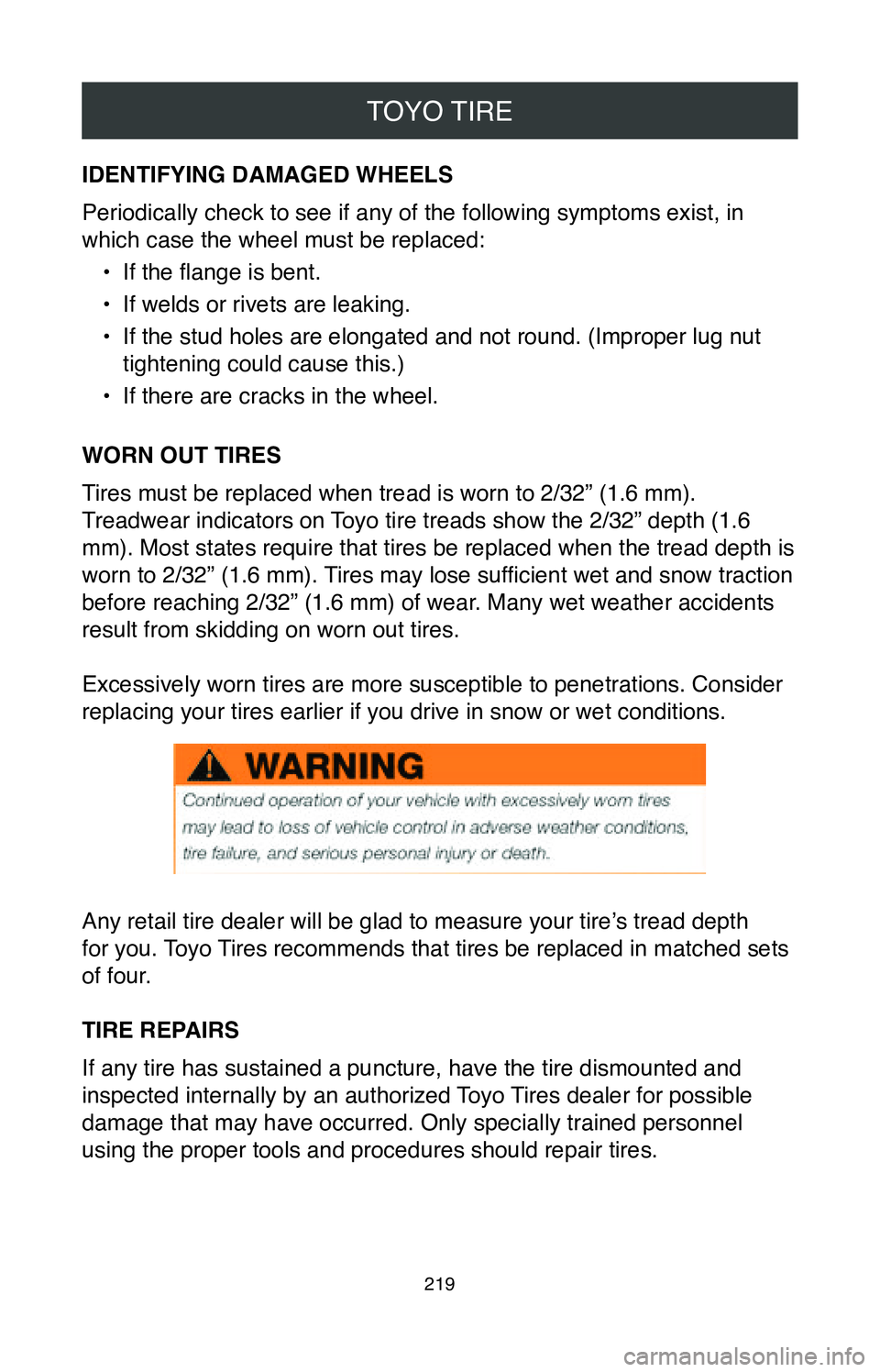
TOYO TIRE
219
IDENTIFYING DAMAGED WHEELS
Periodically check to see if any of the following symptoms exist, in
which case the wheel must be replaced:•
If the flange is bent.
•
If welds or rivets are leaking.
•
If the stud holes are elongated and not round. (Improper lug nut
tightening could cause this.)
•
If there are cracks in the wheel.
WORN OUT TIRES
Tires must be replaced when tread is worn to 2/32” (1.6 mm).
Treadwear indicators on Toyo tire treads show the 2/32” depth (1.6
mm). Most states require that tires be replaced when the tread depth is\
worn to 2/32” (1.6 mm). Tires may lose sufficient wet and snow traction
before reaching 2/32” (1.6 mm) of wear. Many wet weather accidents
result from skidding on worn out tires.
Excessively worn tires are more susceptible to penetrations. Consider
replacing your tires earlier if you drive in snow or wet conditions.
Any retail tire dealer will be glad to measure your tire’s tread depth
for you. Toyo Tires recommends that tires be replaced in matched sets
of four.
TIRE REPAIRS
If any tire has sustained a puncture, have the tire dismounted and
inspected internally by an authorized Toyo Tires dealer for possible
damage that may have occurred. Only specially trained personnel
using the proper tools and procedures should repair tires.
Page 222 of 260
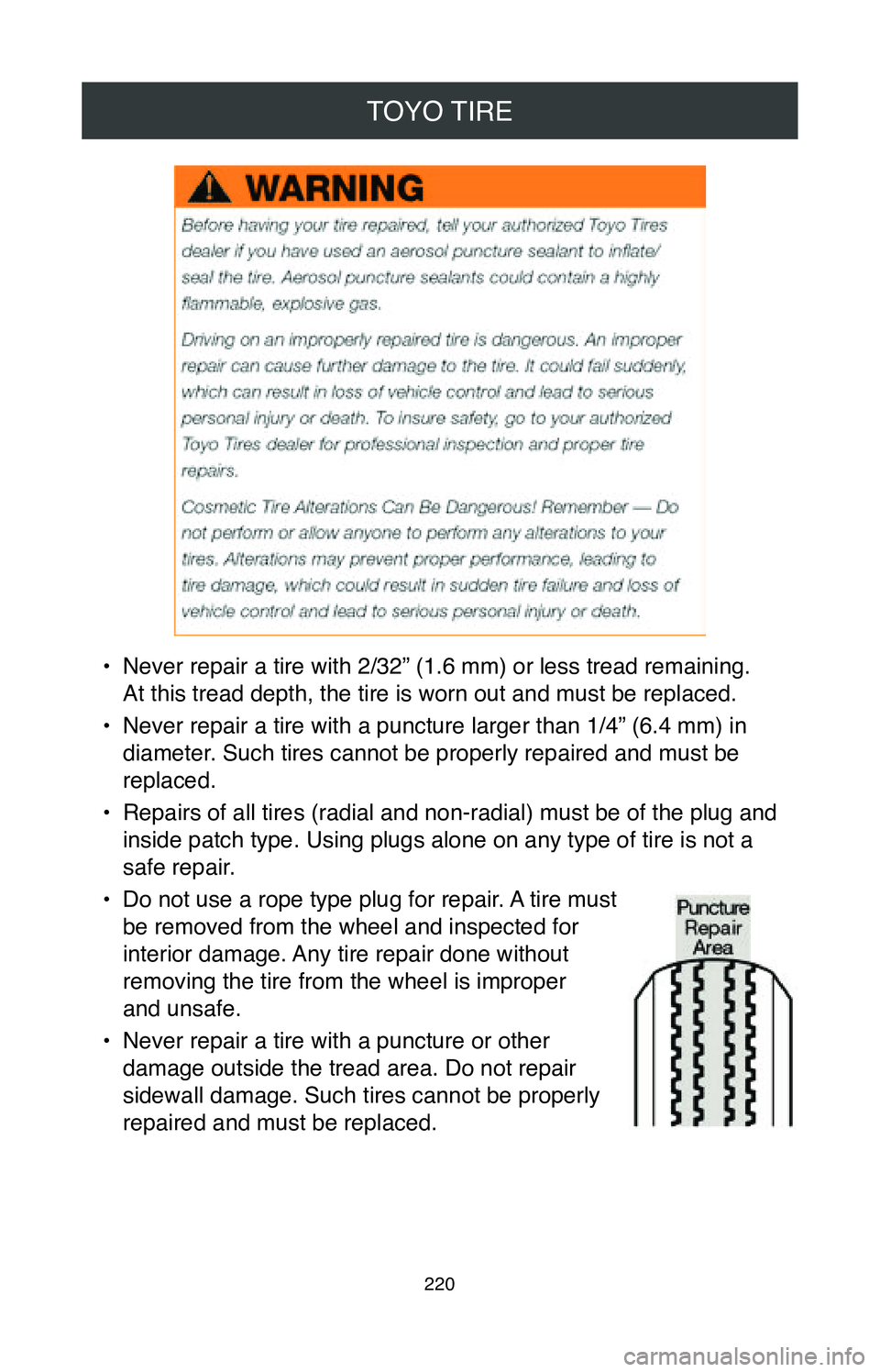
TOYO TIRE
220
• Never repair a tire with 2/32” (1.6 mm) or less tread remaining.
At this tread depth, the tire is worn out and must be replaced.
•
Never repair a tire with a puncture larger than 1/4” (6.4 mm) in
diameter. Such tires cannot be properly repaired and must be
replaced.
•
Repairs of all tires (radial and non-radial) must be of the plug and
inside patch type. Using plugs alone on any type of tire is not a
safe repair.
•
Do not use a rope type plug for repair. A tire must
be removed from the wheel and inspected for
interior damage. Any tire repair done without
removing the tire from the wheel is improper
and unsafe.
•
Never repair a tire with a puncture or other
damage outside the tread area. Do not repair
sidewall damage. Such tires cannot be properly
repaired and must be replaced.
Page 223 of 260
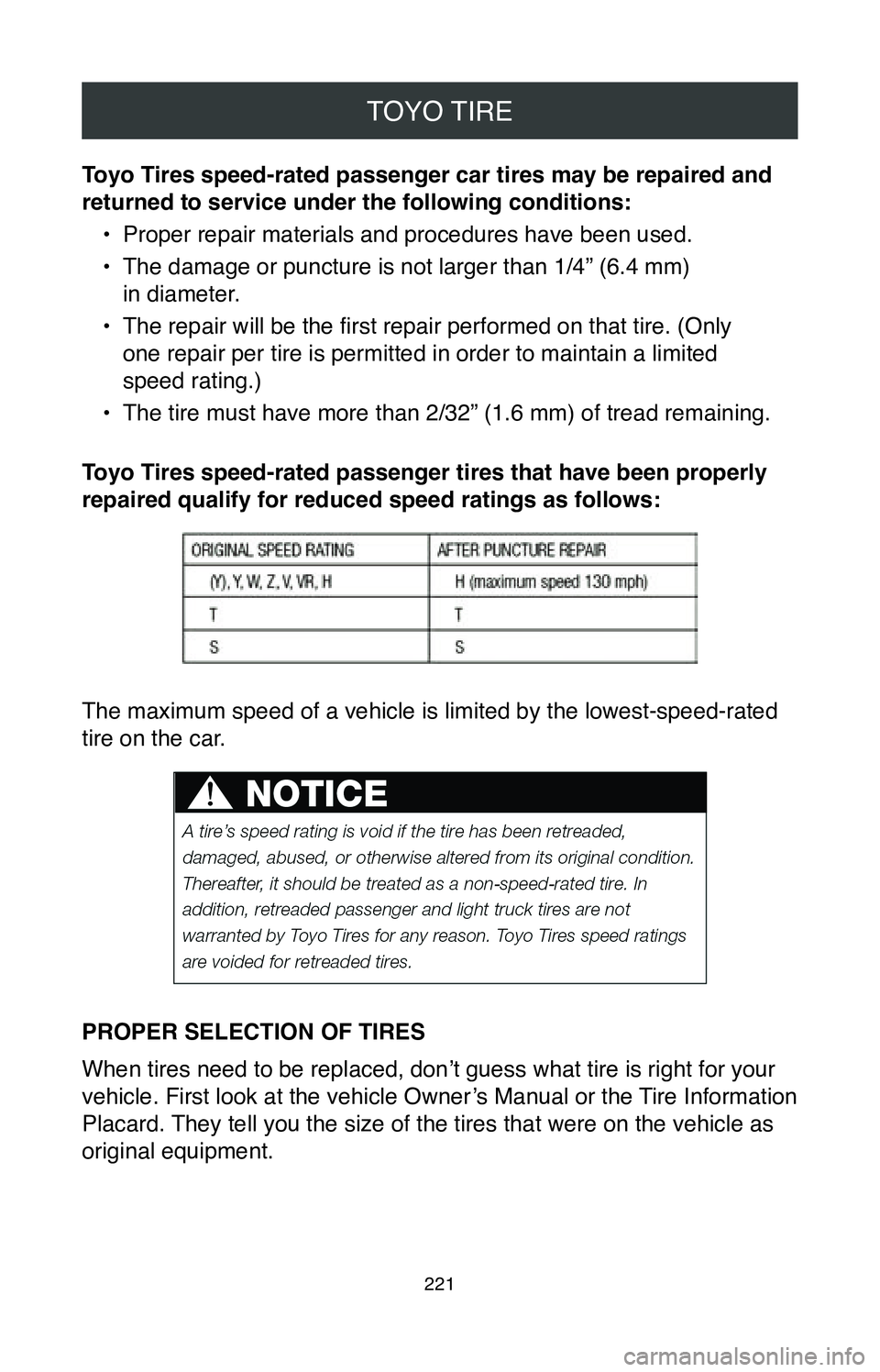
TOYO TIRE
221
Toyo Tires speed-rated passenger car tires may be repaired and
returned to service under the following conditions:•
Proper repair materials and procedures have been used.
•
The damage or puncture is not larger than 1/4” (6.4 mm)
in diameter.
•
The repair will be the first repair performed on that tire. (Only
one repair per tire is permitted in order to maintain a limited
speed rating.)
•
The tire must have more than 2/32” (1.6 mm) of tread remaining.
Toyo Tires speed-rated passenger tires that have been properly
repaired qualify for reduced speed ratings as follows:
The maximum speed of a vehicle is limited by the lowest-speed-rated
tire on the car.
PROPER SELECTION OF TIRES
When tires need to be replaced, don’t guess what tire is right for your
vehicle. First look at the vehicle Owner’s Manual or the Tire Information
Placard. They tell you the size of the tires that were on the vehicle as
original equipment.
Page 224 of 260
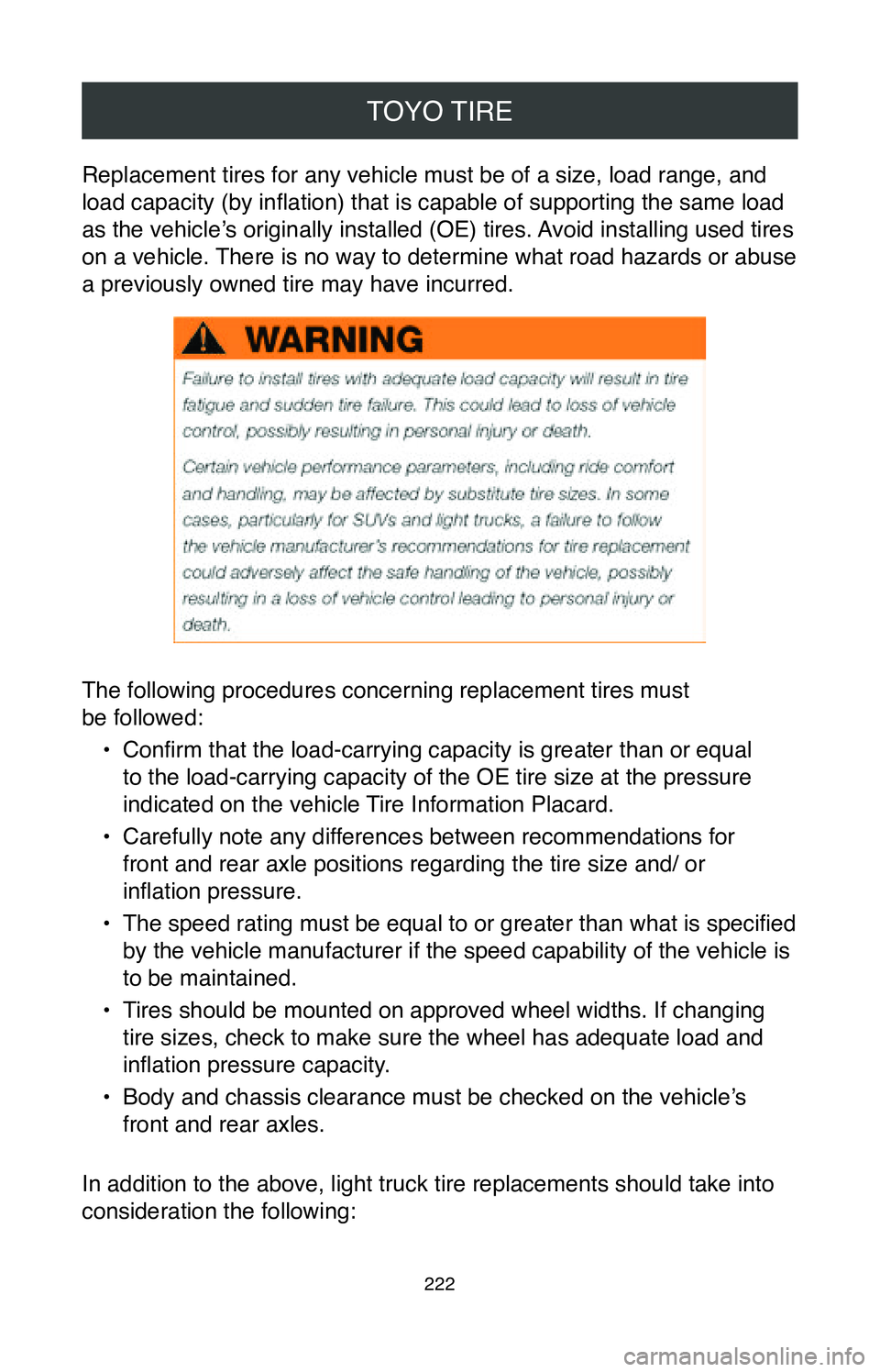
TOYO TIRE
222
Replacement tires for any vehicle must be of a size, load range, and
load capacity (by inflation) that is capable of supporting the same load
as the vehicle’s originally installed (OE) tires. Avoid installing used tires
on a vehicle. There is no way to determine what road hazards or abuse
a previously owned tire may have incurred.
The following procedures concerning replacement tires must
be followed:•
Confirm that the load-carrying capacity is greater than or equal
to the load-carrying capacity of the OE tire size at the pressure
indicated on the vehicle Tire Information Placard.
•
Carefully note any differences between recommendations for
front and rear axle positions regarding the tire size and/ or
inflation pressure.
•
The speed rating must be equal to or greater than what is specified
by the vehicle manufacturer if the speed capability of the vehicle is
to be maintained.
•
Tires should be mounted on approved wheel widths. If changing
tire sizes, check to make sure the wheel has adequate load and
inflation pressure capacity.
•
Body and chassis clearance must be checked on the vehicle’s
front and rear axles.
In addition to the above, light truck tire replacements should take into\
consideration the following:
Page 225 of 260
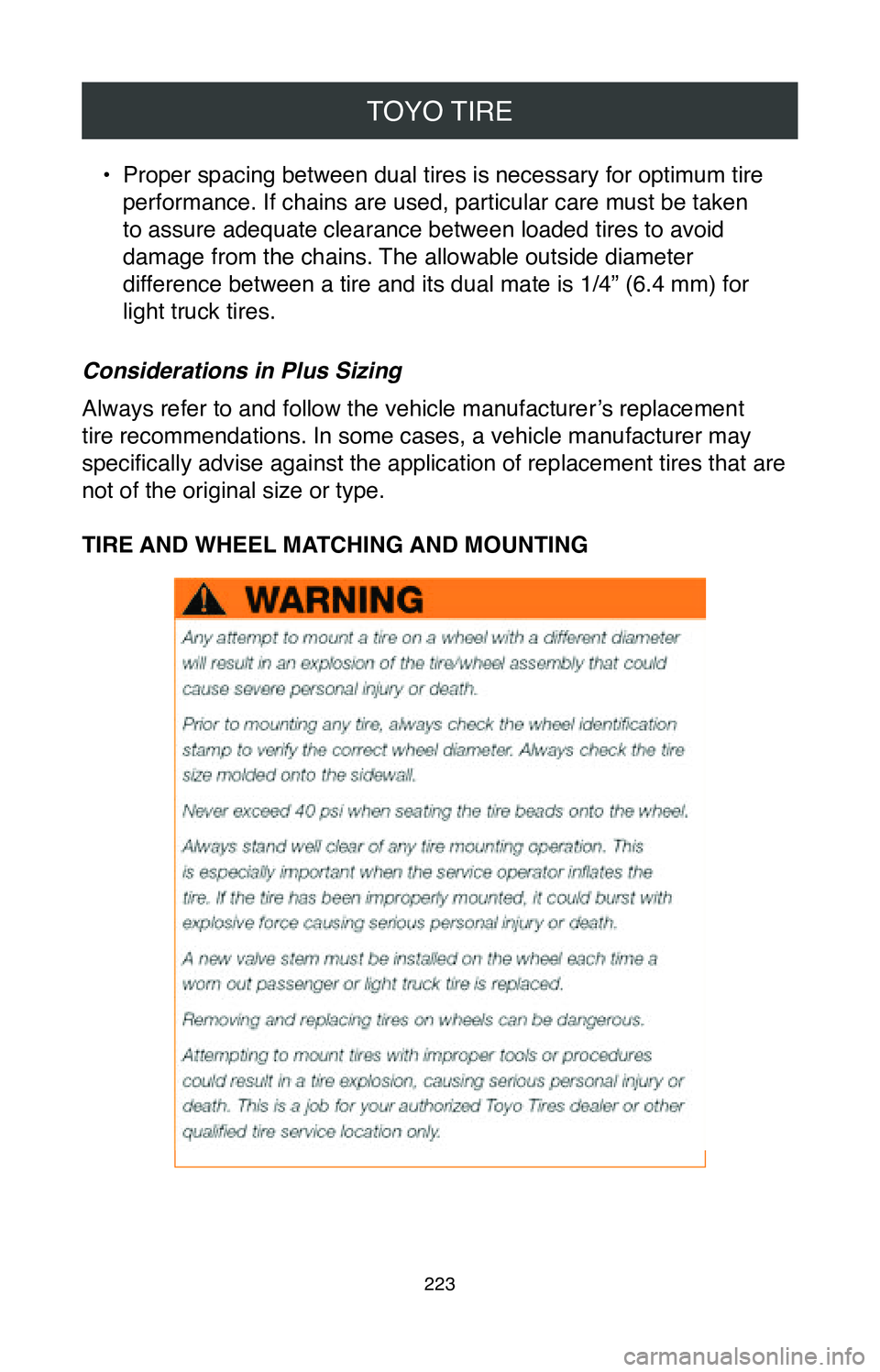
TOYO TIRE
223
• Proper spacing between dual tires is necessary for optimum tire
performance. If chains are used, particular care must be taken
to assure adequate clearance between loaded tires to avoid
damage from the chains. The allowable outside diameter
difference between a tire and its dual mate is 1/4” (6.4 mm) for
light truck tires.
Considerations in Plus Sizing
Always refer to and follow the vehicle manufacturer’s replacement
tire recommendations. In some cases, a vehicle manufacturer may
specifically advise against the application of replacement tires that are
not of the original size or type.
TIRE AND WHEEL MATCHING AND MOUNTING
Page 226 of 260
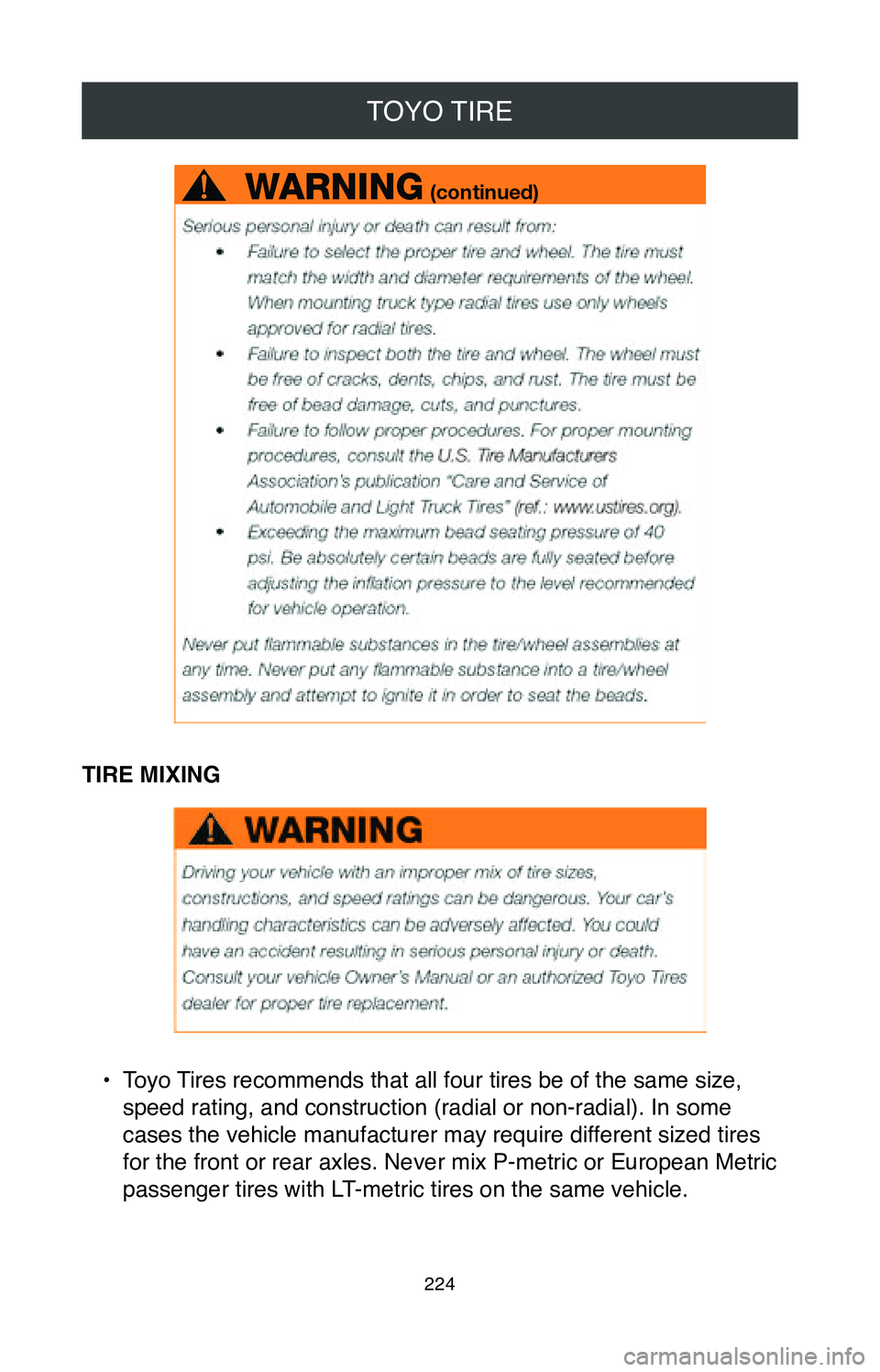
TOYO TIRE
224
TIRE MIXING
• Toyo Tires recommends that all four tires be of the same size,
speed rating, and construction (radial or non-radial). In some
cases the vehicle manufacturer may require different sized tires
for the front or rear axles. Never mix P-metric or European Metric
passenger tires with LT-metric tires on the same vehicle.
Page 227 of 260
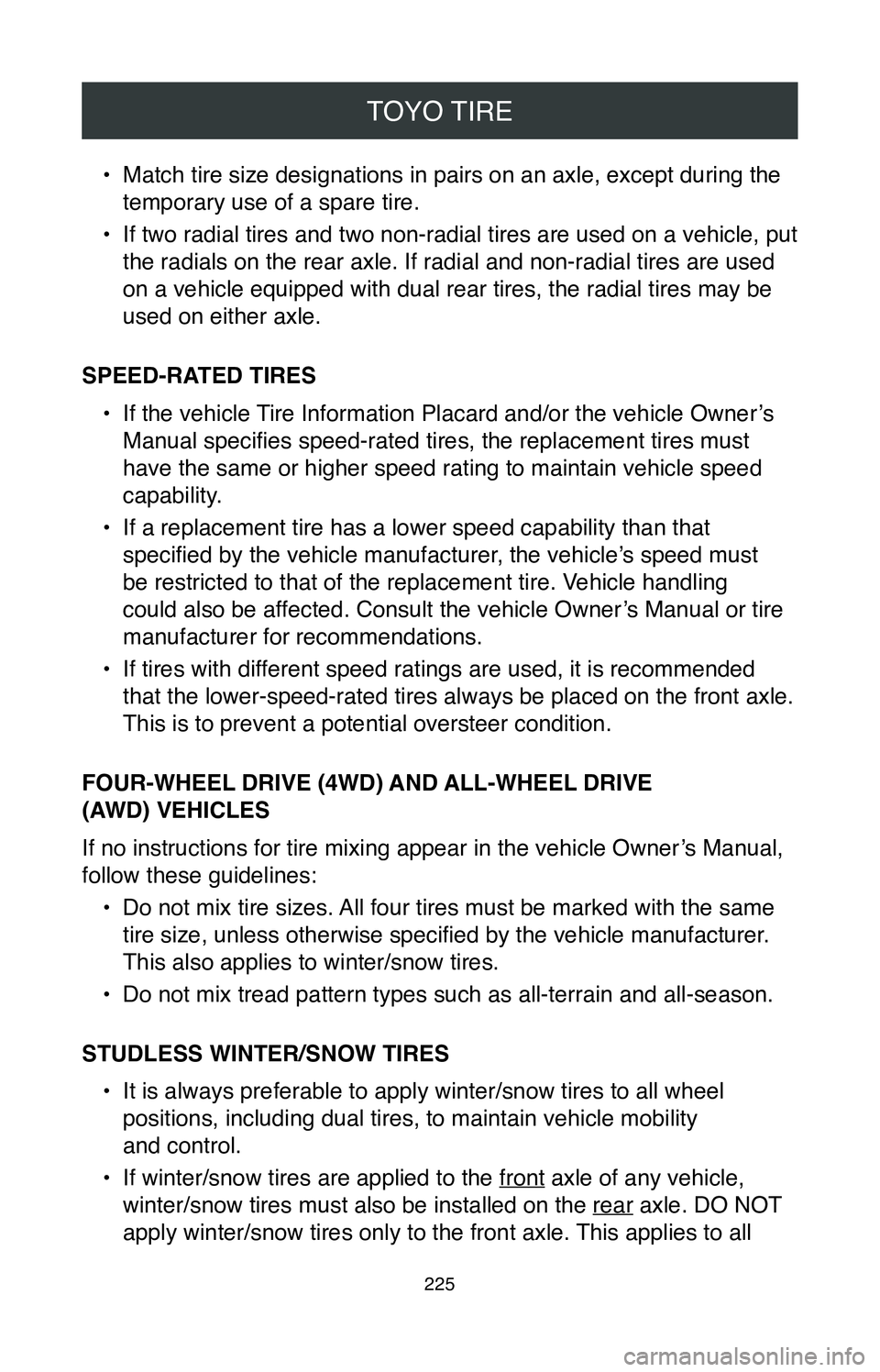
TOYO TIRE
225
• Match tire size designations in pairs on an axle, except during the
temporary use of a spare tire.
•
If two radial tires and two non-radial tires are used on a vehicle, put
the radials on the rear axle. If radial and non-radial tires are used
on a vehicle equipped with dual rear tires, the radial tires may be
used on either axle.
SPEED-RATED TIRES •
If the vehicle Tire Information Placard and/or the vehicle Owner’s
Manual specifies speed-rated tires, the replacement tires must
have the same or higher speed rating to maintain vehicle speed
capability.
•
If a replacement tire has a lower speed capability than that
specified by the vehicle manufacturer, the vehicle’s speed must
be restricted to that of the replacement tire. Vehicle handling
could also be affected. Consult the vehicle Owner’s Manual or tire
manufacturer for recommendations.
•
If tires with different speed ratings are used, it is recommended
that the lower-speed-rated tires always be placed on the front axle.
This is to prevent a potential oversteer condition.
FOUR-WHEEL DRIVE (4WD) AND ALL-WHEEL DRIVE
(AWD) VEHICLES
If no instructions for tire mixing appear in the vehicle Owner’s Manual,
follow these guidelines: •
Do not mix tire sizes. All four tires must be marked with the same
tire size, unless otherwise specified by the vehicle manufacturer .
This also applies to winter/snow tires.
•
Do not mix tread pattern types such as all-terrain and all-season.
STUDLESS WINTER/SNOW TIRES •
It is always preferable to apply winter/snow tires to all wheel
positions, including dual tires, to maintain vehicle mobility
and control.
•
If winter/snow tires are applied to the front axle of any vehicle,
winter/snow tires must also be installed on the rear axle. DO NOT
apply winter/snow tires only to the front axle. This applies to all
Page 228 of 260
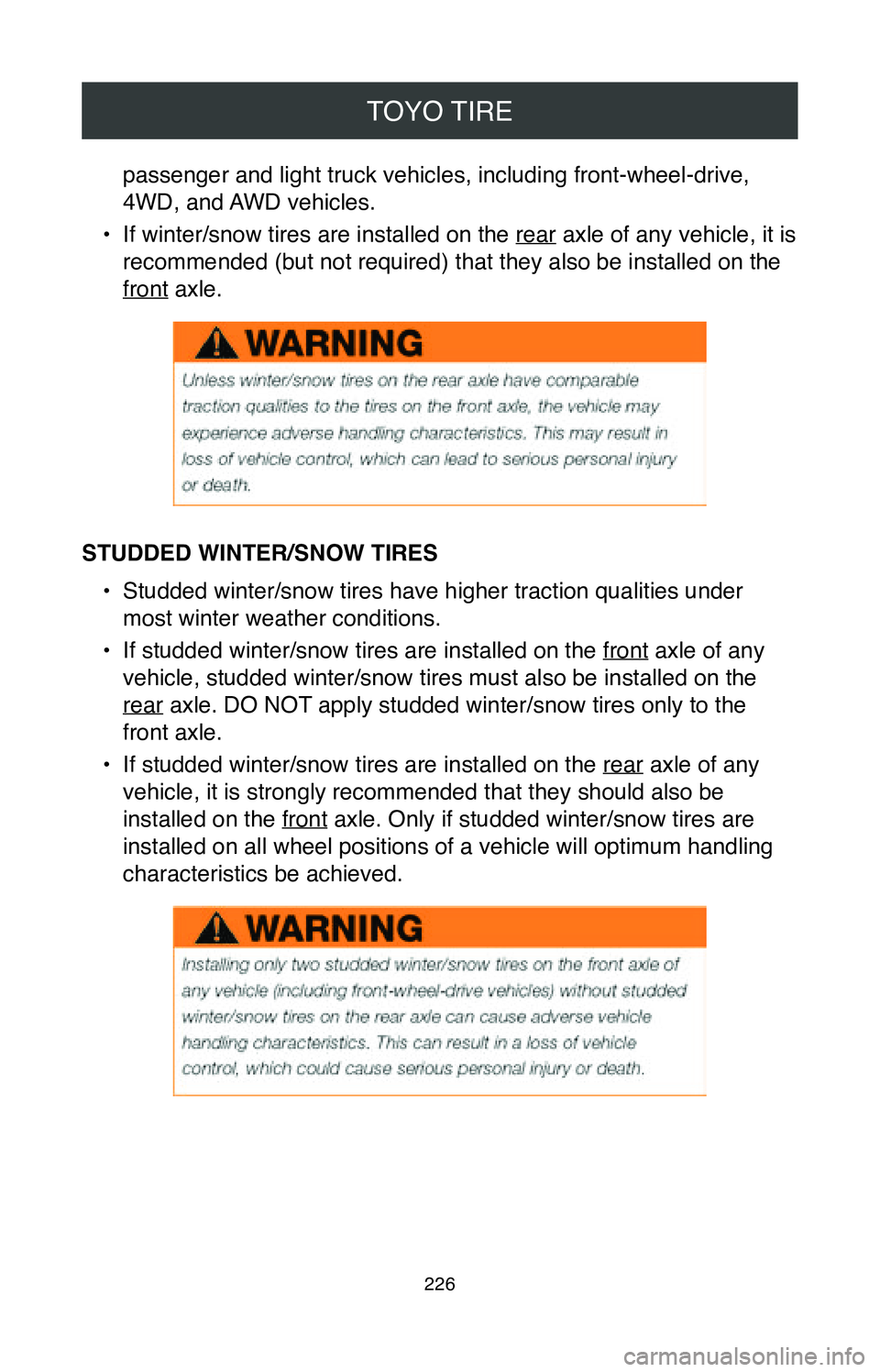
TOYO TIRE
226
passenger and light truck vehicles, including front-wheel-drive,
4WD, and AWD vehicles.
•
If winter/snow tires are installed on the rear axle of any vehicle, it is
recommended (but not required) that they also be installed on the
front axle.
STUDDED WINTER/SNOW TIRES
•
Studded winter/snow tires have higher traction qualities under
most winter weather conditions.
•
If studded winter/snow tires are installed on the front axle of any
vehicle, studded winter/snow tires must also be installed on the
rear axle. DO NOT apply studded winter/snow tires only to the
front axle.
•
If studded winter/snow tires are installed on the rear axle of any
vehicle, it is strongly recommended that they should also be
installed on the front axle. Only if studded winter/snow tires are
installed on all wheel positions of a vehicle will optimum handling
characteristics be achieved.
Page 229 of 260
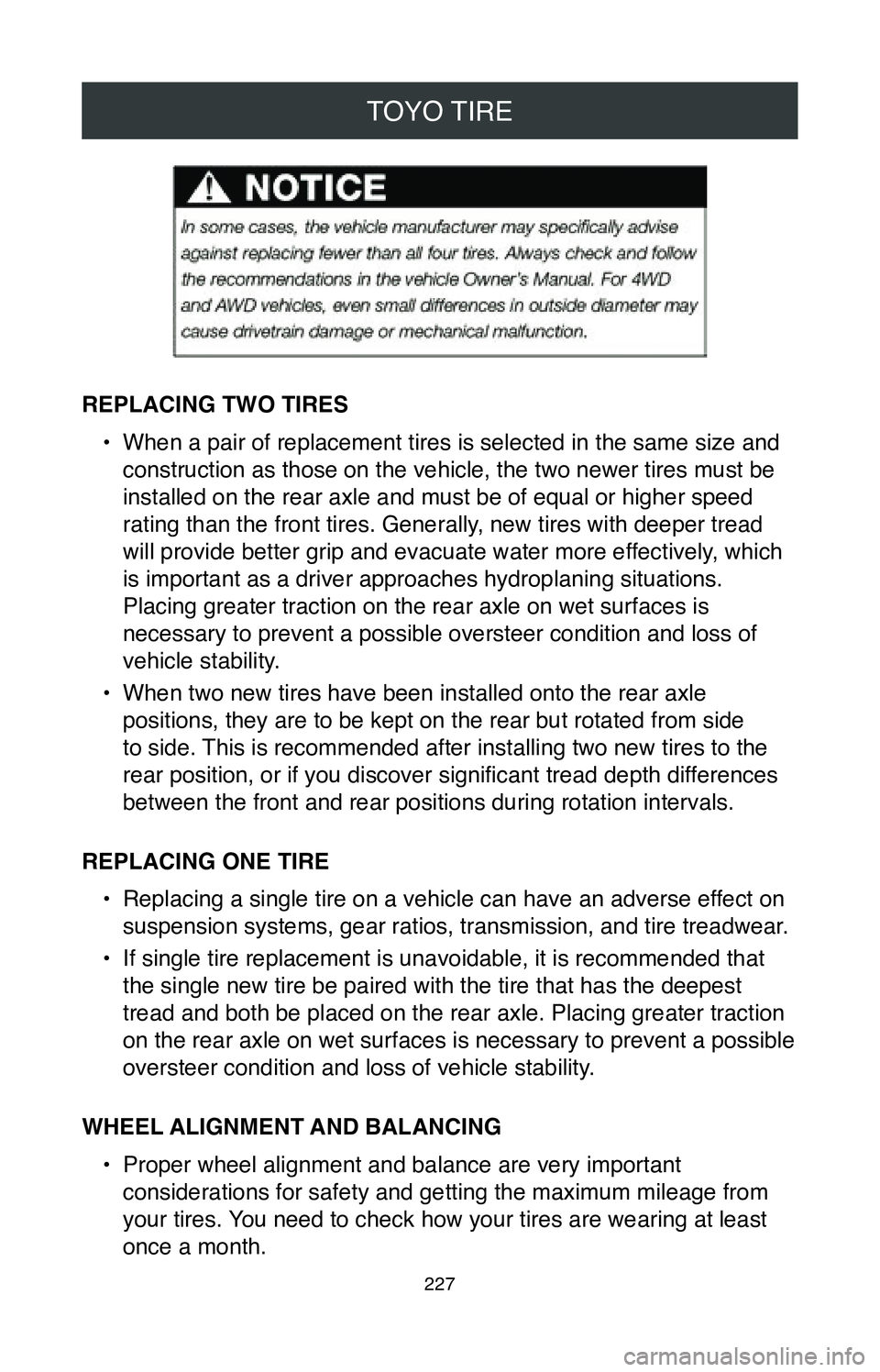
TOYO TIRE
227
REPLACING TWO TIRES•
When a pair of replacement tires is selected in the same size and
construction as those on the vehicle, the two newer tires must be
installed on the rear axle and must be of equal or higher speed
rating than the front tires. Generally, new tires with deeper tread
will provide better grip and evacuate water more effectively, which
is important as a driver approaches hydroplaning situations.
Placing greater traction on the rear axle on wet surfaces is
necessary to prevent a possible oversteer condition and loss of
vehicle stability.
•
When two new tires have been installed onto the rear axle
positions, they are to be kept on the rear but rotated from side
to side. This is recommended after installing two new tires to the
rear position, or if you discover significant tread depth differences
between the front and rear positions during rotation intervals.
REPLACING ONE TIRE •
Replacing a single tire on a vehicle can have an adverse effect on
suspension systems, gear ratios, transmission, and tire treadwear.
•
If single tire replacement is unavoidable, it is recommended that
the single new tire be paired with the tire that has the deepest
tread and both be placed on the rear axle. Placing greater traction
on the rear axle on wet surfaces is necessary to prevent a possible
oversteer condition and loss of vehicle stability.
WHEEL ALIGNMENT AND BALANCING •
Proper wheel alignment and balance are very important
considerations for safety and getting the maximum mileage from
your tires. You need to check how your tires are wearing at least
once a month.
Page 230 of 260
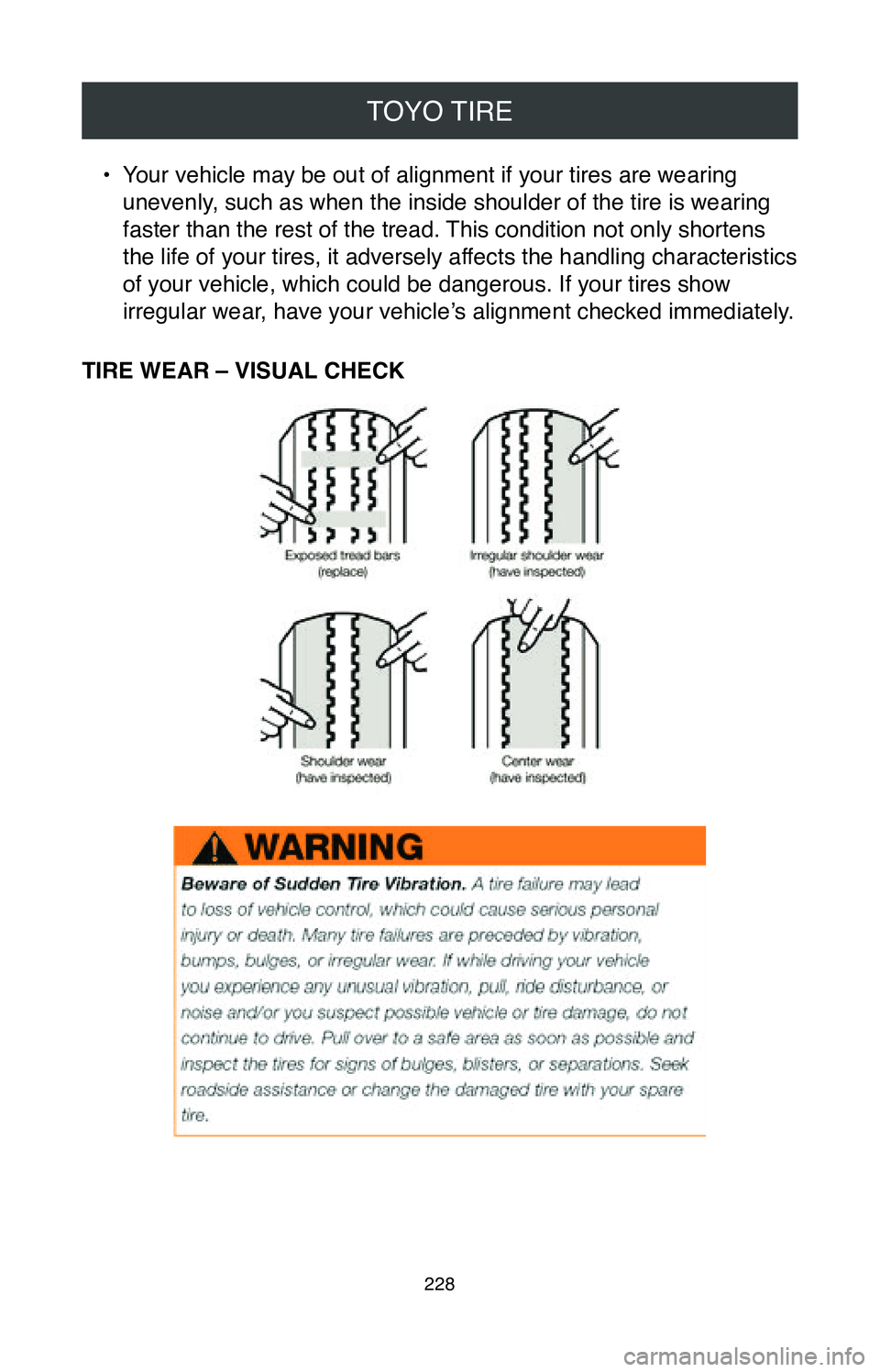
TOYO TIRE
228
• Your vehicle may be out of alignment if your tires are wearing
unevenly, such as when the inside shoulder of the tire is wearing
faster than the rest of the tread. This condition not only shortens
the life of your tires, it adversely affects the handling characteristics
of your vehicle, which could be dangerous. If your tires show
irregular wear, have your vehicle’s alignment checked immediately.
TIRE WEAR – VISUAL CHECK